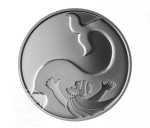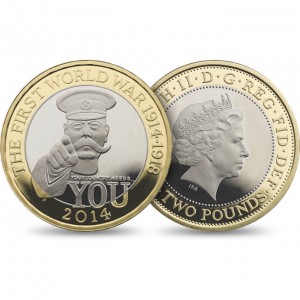
2011 Commemorative celebrating the 100th anniversary of the Royal Dutch Mint’s facilities with QR code on reverse
Three of the last five COTY winners had design elements that were not based on the sculpture of the coin but on a design gimmick. Were these the best designs or did the gimmick influence the voting?
I have asked before whether it is wrong to include other design elements on a coin, especially non-circulating legal tender (NCLT) coins. When I ask these questions, I bring out the picture of my Somalia motorcycle or muscle car coins. I also like the Canadian 2006 Breast Cancer silver commemorative coin and the special 25-cent circulating coin the Royal Canadian Mint produced. These were not overt uses of color but almost an enhancement to emphasize the pink ribbons on the coins.
But is it too much of a gimmick? After the RCM produced those coins it seems that they dove in face first into producing colored coins. It also seems that the rest of the world also has been spending its time printing coins and not minting them (see the New Zealand Mint). Although I am guilty of buying into this type of design concept, there comes a time when the concept has gone too far. In television the concept is called “Jumping the Shark.”
While others are printing coins, the Royal Mint is coming up with designs that are interesting sculptures. In fact, if you go to their website and look at their offerings you will find that the Royal Mint has nice designs, interesting packaging, but no color. Although their artists take advantage of the design elements using bi-metallic coins, they are sculptured arts and not printed designs.
U.S. coin designs have had the best designs over the last few years. However, the introduction of the “enhanced uncirculated” coins with the selective frosting has opened up new ways of enhancing sculpture elements on coins. It would be interesting to see what the U.S. Mint artists can do if given the free hand to design coins and using the laser to enhance the design.
Given the recent history of the COTY competition, the 2014 National Baseball Hall of Fame commemorative coin is almost a shoo-in for 2016 COTY honors. While the elements will be sculpted rather than printed and the curved planchet will be interesting, it is probably enough of a gimmick to sway the World Coin News confab when it meets to discuss the 2014 coin in December 2015.
As an aside, why do we have to wait a year for the COTY competition? With technology what it is today, why does it take a year to do the COTY competition? If the award is given in February, then why select the COTY in December or January? Does it really make sense for the 2014 COTY to be coins date 2012? Why not call it the 2012 COTY since the coins are dated 2012 and award them at the beginning of 2013—or in this case, the 2013 COTY being awarded in 2014?
The one year delay might have made sense when mail delivery was less reliable and information was delayed by the speed of the teletype and the printing press. In the information age where 2012 is not only yesterday’s news it is ancient history, it is time for Krause Publications and World Coin News to modernize their process and come up with something a little quicker than a one year delay.
- 2012 Yves Klein commemorative courtesy of the Monnaie de Paris.
- 2011 Royal Dutch Mint commemorative with QR code courtesy of the Royal Dutch Mint.
- 2010 Jonah in the Whale commemorative courtesy of the Israel Coins & Medals Corp.
- 2009 White Rhinoceros 100 Rand gold coin courtesy of Krause Publications.
- 2008 Mongolia Wolverine coin courtesy of the Wolverine Foundation.
- 2014 British coin images courtesy of the Royal Mint.










One person’s gimmicky coin is another person’s innovative coin. I think there are times when color or special elements or gilding or whatever can help create a nice coin. Look at the 5 oz silver Niue year of the horse 2014 coin with selective gilding. It is an amazingly attractive coin and its issue price was high but the design and 500-coin mintage have pushed prices even higher. Check it out if you have not seen it.
My main beef with the Krause COTY awards, apart from being two-years old as you explain, is that too often the coins chosen are simply not that great in terms of the design. This is similar to your take, but my point is I would have selected different and nicer coins from the same countries or other countries, and I find a lot of collectors agree on which designs really standout. Unfortunately the Krause judges do not seem to agree with collectors, a bit like how our coin design committees often select designs like the new civil rights coins that most collectors do not find very appealing.
Appreciate the attention paid to the Coin of the Year program but wanted to make a few points.
First, the awards aren’t determined by one or two World Coin News staffers sitting in a dark room pushing their personal coin preferences on the public. Coins are nominated by a group of 6-10 people (including many non-KP hobbyists), then voted on by a judging group of about 100 people ranging from collectors to dealers to mint personnel to journalists. This is what they chose. Some people like it, some people don’t. One person’s “gimmick” coin is another person’s “innovative” or “artistic” coin. Call this a gimmick if you’d like, but it’s just one person’s opinion (in fairness, one likely shared by others), as were the votes for the coins submitted by the judges.
Second, regarding the latest year’s coins be honored: we strive to be as complete as possible in cataloging all the coins issued worldwide in a given year before beginning the nomination process. Even with today’s technology, that is quite an undertaking, given the disparity in communication proficiency from different mints. The process typically spills over into the ensuing year. That, combined with the fact that the January/February World Money Fair is clearly the best venue for presenting the awards given the near-total attendance by winning mints, is what sets our schedule.
Scott:
I am not suggesting that something shady is going on with the selection of the COTY. My commentary is on the quality of the selections. Obviously, this is my opinion which I acknowledge is tinged with a little hypocricy since I have gladly purchased my own sets of “gimmicks.”
“Even with today’s technology, that is quite an undertaking, given the disparity in communication proficiency from different mints.”
You’re not joking there!! Our website covers modern gold & silver coins in a very visual way and getting some of these companies to help us help them is nothing short of ridiculous. Some of the big guns are brilliant and a few smaller producers have come out of hiding and been great, but there are many that are almost breathtakingly ignorant. Never seen a market like it to be honest.